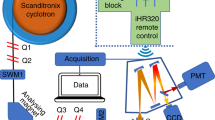Abstract
Photodynamic therapy (PDT) is a promising approach to the local destruction of malignant tumours, but little work has been done to determine which factors control the extent of tissue necrosis produced. Using a new photosensitiser, a sulphonated aluminium phthalocyanine (AlSPc) and light from an argon ion pumped dye laser at 675 nm, we quantified the effects of interstitial PDT in a transplantable fibrosarcoma in rats. At 100mW laser power, thermal effects were comparable to those of PDT, so subsequent studies were carried out at 50 mW, where thermal effects were minimal. The depth of PDT necrosis increased with the logarithm of the applied energy. Tissue concentration of AlSPc was measured by alkali extraction and at all times after sensitisation, correlated well with the necrosis produced with a given light dose. Peak tumour concentration of AlSPc occurred 24-48 h after sensitisation compared with a peak at 3 h in muscle. The peak ratio tumour:muscle was 2:1 at 24 h. Apart from a different time interval to reach the peak sensitiser concentration, the extent of tumour damage varied with the light and sensitiser parameters in a similar way to that found in normal liver, although the optical penetration depth was greater in the tumour (2.5 mm vs. 1.8 mm). At doses of AlSPc below 1 mg kg-1 the diameter of necrosis increased with the logarithm of the dose of sensitiser, and doubling the dose from 0.25 to 0.5 mg kg-1 increased the depth of necrosis by 50%. However, at higher doses, the changes were smaller and increasing the dose from 2.5 to 5 mg kg-1 only increased the necrosis by 10% for the same light dose. In all dose ranges, a given percentage increase in the tissue concentration of AlSPc gave a much smaller percentage increase in the extent of necrosis for the same light dose, suggesting that selectivity of necrosis between tumour and normal tissue is likely to be much less than the selectivity of retention of the photosensitiser. From these results, the extent of PDT necrosis in this fibrosarcoma is as predictable as it is in normal liver if the light dose, tissue concentration of AlSPc and optical penetration depth of the tissue are known. Further studies are now required on different tumour models to establish how tumours respond compared with adjacent normal tissue when the tumour is growing in its organ of origin rather than the non-physiological situation using a transplantable tumour as in this study.
This is a preview of subscription content, access via your institution
Access options
Subscribe to this journal
Receive 24 print issues and online access
$259.00 per year
only $10.79 per issue
Buy this article
- Purchase on Springer Link
- Instant access to full article PDF
Prices may be subject to local taxes which are calculated during checkout
Similar content being viewed by others
Rights and permissions
About this article
Cite this article
Tralau, C., MacRobert, A., Coleridge-Smith, P. et al. Photodynamic therapy with phthalocyanine sensitisation: quantitative studies in a transplantable rat fibrosarcoma. Br J Cancer 55, 389–395 (1987). https://doi.org/10.1038/bjc.1987.78
Issue Date:
DOI: https://doi.org/10.1038/bjc.1987.78
This article is cited by
-
Extended necrosis of the oesophageal wall after photodynamic therapy: Report of two cases
Lasers In Medical Science (1993)
-
Liposome- or LDL-administered Zn(II)-phthalocyanine as a photodynamic agent for tumours III. Effect of cholesterol on pharmacokinetic and phototherapeutic properties
Lasers in Medical Science (1990)
-
Tetrapyrroles: A chemical class of potent photosensitizers for the photodynamic treatment of tumours
Lasers in Medical Science (1990)
-
Photodetection and photodynamic therapy of ‘early’ squamous cell carcinomas of the pharynx, oesophagus and tracheo-bronchial tree
Lasers in Medical Science (1990)
-
Photodynamic therapy for colorectal disease
International Journal of Colorectal Disease (1989)



